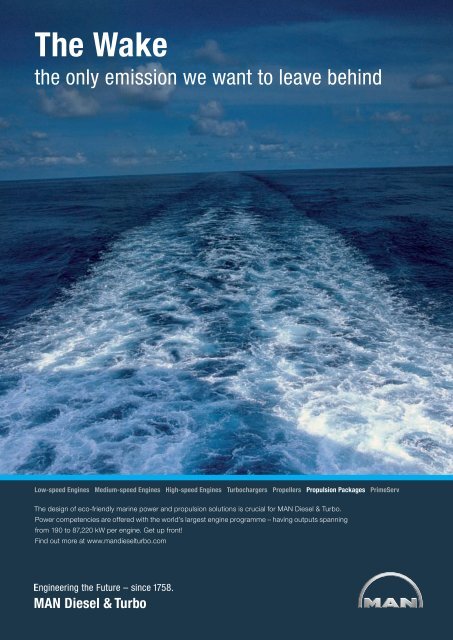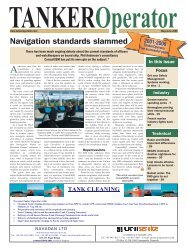Features: - Tanker Operator
Features: - Tanker Operator
Features: - Tanker Operator
You also want an ePaper? Increase the reach of your titles
YUMPU automatically turns print PDFs into web optimized ePapers that Google loves.
INDUSTRY - MARKETS<br />
# of Vessels<br />
100<br />
Additions<br />
75 Deletions<br />
50<br />
40<br />
32<br />
25<br />
60<br />
< ACTUAL | FORECAST ><br />
86<br />
63<br />
YTD 15<br />
45<br />
0<br />
0<br />
-2<br />
-25<br />
-24<br />
-39 -37<br />
YTD -16<br />
-32<br />
-50<br />
2007 2008 2009 2010 2011 2012<br />
Source: McQuilling Services<br />
Figure 1: VLCC fleet additions and deletions.<br />
Source: McQuilling Services<br />
Figure 2: Ras Tanura/West via extended anti-piracy route.<br />
commercial matters, rather than the cargo<br />
owners, especially where the financial aspects<br />
were concerned. “This is a big change over<br />
the past 40 years,” he said.<br />
McQuilling’s Dave Saginaw said that the<br />
products trades were moving into larger<br />
tonnage. Next year will see 900 product<br />
carriers delivered of over 27,500 dwt, which<br />
should be the peak in the newbuilding boom.<br />
Colin Cridland, also of Clarkson, said that<br />
the increase in the number of MRs is being<br />
seen at the same time as time spent in port is<br />
being reduced. He also commented that there<br />
was only 10% of the current product tanker<br />
fleet that was still of single hull construction.<br />
Slow steaming was having an effect as some<br />
tankers were sailing at around 12 knots<br />
instead of 14 knots to save fuel.<br />
In the smaller tramp trades, Quincannon’s<br />
Soren Wolmar said that there had only been a<br />
modest increase in two years, but this year<br />
could see around 600 vessels joining the fleet.<br />
Thereafter 190 were due for delivery next<br />
year, 31 in 2012 and only six in 2013, thus far.<br />
New owners tended to rely on the spot<br />
markets and there would be more<br />
MEG/Southeast Asia movements seen in<br />
products as a change in sourcing kicks in.<br />
Overall, future tonne/miles patterns were<br />
unpredictable and the tanker industry is faced<br />
with a very young fleet. Difficult to facture<br />
into the equation are newbuilding<br />
postponements and cancellations and there<br />
will be a certain amount of consolidation, as<br />
has been seen recently.<br />
The MR IMO II types will see no<br />
sustainable improvements without CPP<br />
cargoes, while smaller tramp tankers will<br />
suffer from unreliable spot rates. Parcel<br />
tankers will still be at the mercy of port<br />
congestion and disruptions to the supply<br />
chain.<br />
MR prospects<br />
Remaining with MRs, London’s Gibson<br />
Research said that tanker demand had come<br />
under tremendous downwards pressure in the<br />
past two years.<br />
There has been some support for VLCCs,<br />
Suezmaxes, LR2s and LR1s from floating<br />
storage, but for MRs there was no such relief.<br />
However, the driving forces for MR product<br />
tanker demand are far more complex than for<br />
crude oil; product trade can increase by a lot<br />
more than gains in oil demand and volumes in<br />
to or out of a country can rise even if its oil<br />
demand falls.<br />
Focusing on Asia and looking at the main<br />
petroleum products carried by MRs, over the<br />
past two years Japanese oil demand has fallen<br />
by 0.55 mill barrels per day (minus 14%) and<br />
yet the combined total of product imports and<br />
exports on an annual average basis remained<br />
unchanged at around 1.15 mill barrels per day<br />
(imports were down by 0.1 mill b/d, but<br />
exports were up by a similar amount).<br />
This illustrates the intricate nature of<br />
product trades and that total oil demand can<br />
be a misleading indicator. In the same way,<br />
2009 oil demand in South Korea was the same<br />
as in 2007 and yet product import/export trade<br />
increased by 20% over the two years, from<br />
1.25 mill barrels per day to 1.50 mill barrels<br />
per day.<br />
We are all aware of the rapid expansion in<br />
Chinese oil demand and the strategy to build<br />
domestic refining capacity to meet these<br />
requirements, Gibson said. However, over<br />
2007-09 product imports were up by 0.1 mill<br />
barrels per day and exports increased by 0.2<br />
mill barrels per day.<br />
All this reflects the fact that just because the<br />
refining capacity is there, it doesn’t mean the<br />
supply of each type of product will, or can, be<br />
matched exactly with domestic demand. As a<br />
result there will be ‘surplus’ products to<br />
export and ‘deficit’ products to import.<br />
However, for each country, this position will<br />
be constantly changing.<br />
Assessing market changes between 2007-<br />
09, Asia/Pacific oil demand increased by less<br />
than 3% and yet annual average product trade<br />
to/from key countries increased by 17%.<br />
Ordinarily this would have led to a stronger<br />
MR market, but the market fundamentals in<br />
the west have been far weaker than the east. In<br />
addition, we have seen a 20% increase in the<br />
MR fleet over the past two years, Gibson<br />
commented.<br />
Nonetheless, Asian product trade is<br />
expected to continue to rise and growth in MR<br />
numbers will slow, but not until 2012. Thus,<br />
the basis for an MR turnaround is there, but<br />
we will still have to wait for a while, Gibson<br />
concluded.<br />
At the INTERTANKO seminar, some<br />
experts thought that owners would shy away<br />
form the more sophisticated vessels, due to<br />
higher operating costs. Nobody thought that<br />
carbon fossil fuels would be significantly<br />
replaced in the near future with one speaker<br />
saying that renewable energy would only<br />
account for 1% in 50 years time and he did<br />
not believe in the concept of carbon capture.<br />
OCIMF’s and Shell’s Jan Kopernicki thought<br />
that by 2050, there would be a 70% energy mix<br />
of oil and gas. The main challenges were<br />
security, trade and the environment, he said. He<br />
also warned; “there is a paradigm shift – the<br />
old doesn’t apply any more.”<br />
TO<br />
06<br />
TANKER<strong>Operator</strong> June 2010
















